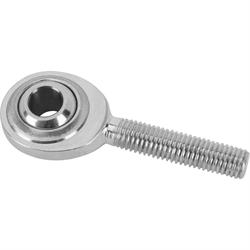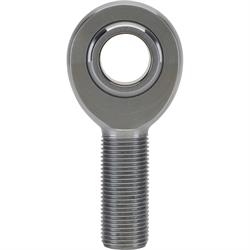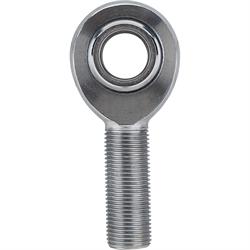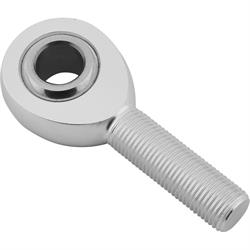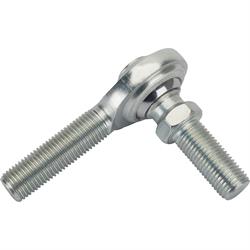Rod End and Heim Joint Buyers Guide
Speedway's vast selection of rod ends offer a large range of shank and hole size configurations, as well as a wide variety of strength and weight options depending upon what is required for your application. Whether it's for general purpose, heavy duty, race or off-road applications you can compare the features of these five main designs.
Heim Joint vs Rod End
You may have noticed the terms Heim Joint and Rod End used interchangeably in the industry. The truth is they are one in the same. Heim is actually a brand name from the early 40's when the first rod ends were produced. Heim Joint became such a popular term that the name stuck and has become commonplace for describing a rod end. This is no different than calling a facial tissue a Kleenex or a soft drink a Coke!
Standard Rod Ends
- Static load rated at 12,000lbs
- Designed for standard duty applications
- Carbon steel body
- Used with clutch, brake, steering, and suspension
- 2-piece construction (body, ball)
- Shop Standard Rod Ends
Standard rod ends are suggested for light duty applications which see minimal movement and when low cost is a primary requirement. They can be used on suspension applications but they will wear quicker than other types of rod ends and replacement will be needed more frequently.
Precision Rod Ends
- Static load rated at 15,000lbs
- Designed for standard duty applications
- Carbon steel body
- Used with clutch, brake, steering, and suspension
- 3-piece construction (body, liner, ball)
- Shop Precision Rod Ends
Precision rod ends are an excellent choice for suspension components on street driven cars at mild to medium power levels. The Kevlar race and PTFE liner make for a self lubricating and long lasting joint. These are quieter and smoother operating than Standard or Pro-1 rod ends. The down side to the Precision line of rod ends is a slightly reduced misalignment angle compared to Standard or Pro-1.
Pro-1 Rod Ends
- Static load rated at 25,000lbs
- Designed for heavy duty applications
- Black oxide coated chromoly steel body
- Used with steering and suspension components
- 2-piece construction (body, ball)
- Shop Pro-1 Rod Ends
Pro-1 rod ends are an excellent choice for steering and suspension on medium to high horsepower racing applications. High load ratings provided by the chromoly steel body and two piece design with excellent misalignment specs lend itself well to all sorts of off-road and racing applications, especially circle track suspensions.
Chromoly Rod End
- Static load rated at 28,000lbs
- Designed for extreme duty applications
- Heat treated 4130 chromoly steel body
- Used with high load steering and suspension
- 3-piece construction (body, liner, ball)
- Shop Chromoly Rod Ends
Chromoly rod ends are an excellent choice for racing suspensions and other high load applications. The 4130 chromoly steel body along with an injection molded Kevlar race and PTFE liner reduce friction and provide self lubrication. The large body design increases strength at the expense of reduced misalignment. These work well in many off-road and high horsepower racing suspensions, especially drag racing rear suspensions.
Aluminum Rod Ends
- Static load rated at 10,000lbs
- Designed for medium duty applications
- Lightweight, heat treated aluminum body
- Designed for motorsports where weight is critical
- 3-piece construction (body, liner, ball)
- Shop Aluminum Rod Ends
Aluminum rod ends are ideal for racing applications where reduced weight is critical and a slight reduction in load rating is acceptable. The injection molded Kevlar race with PTFE liner provides self lubrication and reduces friction. Aluminum rod ends are widely used on circle track cars where rules allow them, typically Sprint Cars and Late Models.
2-Piece vs. 3-Piece Heim Joints
When selecting a heim joint or rod end, a key consideration is its construction: 2-piece versus 3-piece designs. A 2-piece heim joint features a design where the spherical ball directly contacts and articulates within a formed portion of the joint's body, which is typically swaged around the ball. This metal-to-metal configuration offers a balance of strength and cost-effectiveness, providing good radial and axial strength and often allowing for a high degree of misalignment. They are commonly found in more economical or general linkage applications. In contrast, a 3-piece heim joint incorporates a separate, often heat-treated, race or liner that sits between the ball and the outer body. This multi-component construction allows for tighter tolerances, a more precise fit, and a larger bearing surface, often enhanced by self-lubricating materials like PTFE with Kevlar for improved wear resistance and smoother operation. While sometimes offering slightly less misalignment capability than their 2-piece counterparts, 3-piece designs are generally favored for high-performance, racing, or heavy-duty off-road applications due to their superior precision, durability, and extended lifespan.
Specialty Rod Ends
A variety of specialty rod ends are available from Speedway Motors as well, including steering shaft heim joints designed for supporting 3/4" diameter steering shaft, chrome-plated heim joints for the suspension on your show car, 11/16" tie rod heims that can be used in place of a 11/16"-18 tie rod end, and a variety of male or female rod ends with a stud, which are ideal for making carburetor, brake or shift linkages.
Rod End Spacers and Seals
A broad selection of rod end spacers are available to aid in installation of your rod ends. From standard spacers, to cone spacers or even high-misalignment spacers the choices are nearly endless.
Another great addition to your rod ends are seals from Seals-It. These will seal out dirt and debris which will increase service life of your rod ends and reduce maintenance intervals.
